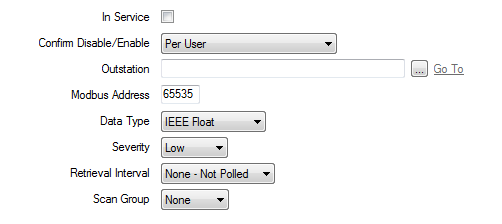The configuration Form for each type of point has a tab specifically for that point type. Use the fields at the top of the <Point Type> tab to configure the common point properties.
The following fields are common to most points on TBox outstations. For fields that are not described here, see the relevant point configuration section within this guide.

Use to specify whether the point is active or inactive (see Placing an Item In Service).
Users with the required permissions can disable a point that is In Service, or enable a point that is not In Service. Such actions are carried out using the Disable Point and Enable Point pick actions.
Use the Confirm Disable/Enable combo box to specify whether a confirmation dialog box is displayed whenever an operator requests that this point is disabled or enabled (see Requesting Confirmation of Action Requests).
Use to specify the outstation on which a point is located. Use the browse button to display a Reference browse window and select the relevant outstation from the window.
The Go To link opens the Properties Form of the outstation you have selected.
Specify the address of this point. The address is set when the RTU is commissioned, and has to be unique on the outstation.
Use this combo box to define the severity of any non-state events or alarms for the point. For more information on severities, see Defining Severities.
Use this combo box to determine how often the server polls the outstation to retrieve the point's current data.
The server only polls the outstation for the point's data when:
- The server, driver, channel, set, outstation, or point has become active (In Service) after previously being inactive (not In Service). For example, when the point is placed In Service following its creation in the database.
- The outstation on which the point is located has been out of communications with the server and communications are restored.
- The Refresh pick action is triggered on the outstation.
The server polls the outstation for the point's current data at timed intervals. The intervals available to be selected are defined in the Properties of the outstation where this point is located (see Define the Data Retrieval Intervals).
The server constantly polls the outstation for the point's current data.
Use the combo box to specify the Scan Group with which the point is associated. The Scan Group determines the frequency with which the driver updates the server with the current value for the point. The Scan Groups are defined on the Scan Parameters tab of the associated Channel Form (see Define Intervals for Timed Current Data Updates).
With most types of point, the specified Scan Group triggers a poll for data at the corresponding Scan Group interval. You therefore typically assign a Scan Group that has an interval that is a multiple of the point’s Retrieval Interval rate. Be aware that if a Scan Group is specified that has a faster interval than the Retrieval Interval, polling will occur at the Scan Group rate (however, this is not recommended).